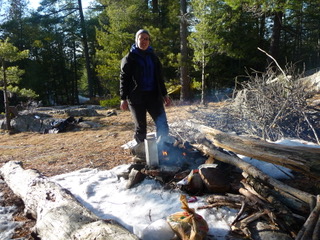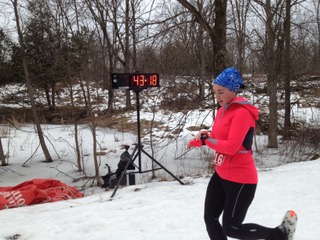Pulk Packing Planning
Welcome to a new three-part series of articles by Ontario ultra, trail, and snowshoe runner Jennifer Cockcroft. Follow Jennifer as she prepares for her winter running goals that lean far toward the adventurous end of things. As we at SHA are fond of saying, 'Let it snow!' We're sure Jennifer agrees!
After a year of getting back into running and ultra-hiking, I started to think about winter goals. I love to snowshoe run and hike, and cross-country ski, but want something more. I used to lead winter backpacking trips, though it's been some time, and I miss them. I want a different challenge - so the plan to 'pulk pack' for overnight winter trips was born!
Why? Because more and more, I am less interested in races. I want to challenge myself on my own, and against the elements. I want to be self-sufficient in all seasons, and push myself to grow as an athlete and as a person. Solo winter trips are an amazing way of doing that, as you have to be very self-aware and in tune with your surroundings.
I started by researching pulks, which are expensive to buy, and in speaking to Derrick he showed me a number of his designs and encouraged me to build my own pulk. There are lots of great designs on the internet and I soon learned about different sleds (such as lightweight kid's sleds!), ropes, poles, and harnesses for pulling (I plan to re-purpose a climbing harness). Lots of fun stuff, and I have recruited my handier-than-me partner to help with building it.
Sara, my coach, and I worked on building a strength plan, such as tire pulling, that would prepare me for the physical demands of pulling a pulk.
Next I started thinking about other gear - the tent that I've generally used winter camping is an ultralight 3-season tent that has seen better days. As I am planning to do solo trips and won't have another body for heat, I want something warmer, so I am getting a heavier 4-season tent. Weight matters, even when pulling a pulk, versus carrying a pack on your back. However, most of my other gear is ultralight, or lightweight (like my -30C sleeping bag with windstopper material). I have a great 4-season sleeping pad that reflects heat back up, which is nice as I'm a cold sleeper. I also have a lightweight axe which is handy for both splitting wood and getting water. An emergency communicator device also makes the list; it's good to have even when going on trips with other people, but when solo in more dangerous conditions (as -30C or colder can be), it's essential.
Some people chose to 'hot tent' - use a canvas tent with a wood stove - but that's not how I've ever winter camped, and I don't want to haul that weight around! Others go ultralight and use a bivy (a glorified sleeping bag cover). I considered a bivy, but want more space and don’t expect to be moving with the speed that you’d want a bivy for – maybe one day!
I also have decided to upgrade my snowshoes for trips to the Dion 166 hiking frames. The Dion 121 running frames for racing have been my favourite-ever snowshoes, so this is a no-brainer as I can just switch the frames from my current bindings and cleats.
I've started to think about trips. I want to test the pulk out on relatively flat ground prior to going on more technical hilly trail, to ensure the system works without getting run off a hill by the pulk coming from behind me! I will do a trip on the old rail bed in Algonquin Provincial Park once we get snow, as it is flat, and there are some places I can make campsites along the way.
I have at least two other trips planned through March, at different places in Ontario's north and east. I want to learn how quickly I move with the pulk, particularly if I'm breaking trail. Longer more difficult trips will probably wait until the winter of 2018-2019.







































